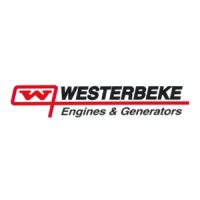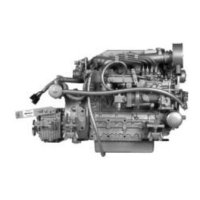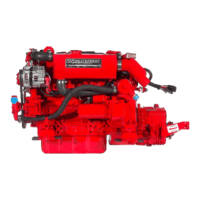)
)
\
LAY-UP
&
RECOMMISSIONING
Starter
Motor
Lubrication
and
cleaning of
the
starter drive
pinion
is
advis-
able,
if
access
to
the
starter permits
its
easy removal. Make
sure
the
battery connections
are
shut off before attempting
to
remove
the
starter.
Take
care
in
properly replacing
any
electri-
cal
connections removed
from
the
starter.
Cylinder
Lubrication
[Diesel]
If
you
anticipate a long lay-up period
(12
months
or
more)
WESTERBEKE
recommends removing
the
glow
plugs
or
fuel
injectors
for
access
to
the cylinders. Squirt light
lubricating
oil
into
the cylinders
to
prevent the
piston
rings
from
stiCking
to
the cylinder
walls.
Rotate the engine
by
hand
two
revolutions
then
replace the
glow
plugs or injectors.
Make
sure you
have
a replacement if removing
the
injector
sealing washer for the injector
and
fuel
line
return.
NOTE:
If
engine
storage
is
going
to
be
a
lengthy
one,
12
months
or
beyond,
it
is
wise
1lJ
rotate
the
engine
by
hand
two
complete
tums every additional 4 months
to
allow
the
i'!iec-
tion
pump
components to
move.
This
will help prevent their
sticking
during extended storage periods.
Intake
Manifold
and
Thru-Hull
Exhaust[Diesel]
Place
a
clean
cloth, lightly soaked
in
lubricating
oil,
in
the
opening
of the intake manifold to block the
opening.
Do
not
shove
the
cloth out
of
sight.
(If it
is
not
visible
at
recommissioning, and
an
attempt
is
made to start
the
engine,
you
may
need
the
assistance
of
a servicing
dealer.)
Make
a
note
to remove
the
cloth prior to start-up. The through-hull
exhaust port
can
be blocked
in
the same
manner.
Intake
Manifold
[Gasoline]
Clean
the
filter screen
in
the
flame
arrester, and place a
clean
cloth
lightly
soaked in lube oil around the
flame
arrester
to
block
any
opening. Also place
an
oil-soaked
cloth
in
the
through-hull
exhaust
port,
Make
a note
to
remove cloths prior
to
start-up!
Transmission
[Propulsion
Engine]
Check
or
change
fluid
in
the transntission
as
required.
If
the
engine
is
to
be layed
up
12
months
or more,
fill
the
transmis-
sion
to
the
very
top
to prevent corrosion. Lower the fluid to
its normal
at
recommissioning.
Wipe
off grime
and
grease
and
touch
up
unpainted areas. Protect coupling
and
output
flange
with
an
anticorrosion coating, Refer
to
the
TRANSMISSION SECTION
in
tltis
manual
for
additional
infonnation.
Batteries
If
batteries
are
to
be
left
on
board during
the
lay-up period,
make
sure
they
are
fully
charged,
and
will
remain
that
way,
to
prevent
them
from
freezing.
If
there exists
any
doubt that
the
batteries
will
not
remain
fully
charged, or that
they
will
be
subjected
to
severe
environmental
conditions,
remove
the
batteries
and store them
in
a
warmer,
more compatible
environment.
SPARE
PARTS
Lay-up
time
provides a
good
opportunity
to
inspect your
WESTERBEKE engine to see if external items such
as
drive
belts
or
coolant hoses
need
replacement. Check your basic
spares kit
and
order items not
on
hand,
or
replace those items
used
during
the
lay-up,
such
as
filters
and zinc
anodes.
Refer
to
the
SPARE
PARTS
section of
tltis
manual.
RECOMMISSIONING
The
recomntissioning of your WESTERBEKE engine after a
seasonal
lay-up
generally
follows
the
same procedures
as
those
described
in
the
PREPARATIONS
FOR
STARTING
sec-
tion
regarding preparation
for
starting and
normal
starts.
However,
some
of the lay-up procedures
will
need
to
be
counteracted before starting
the
engine.
1.
Remove
any
rags that were placed in
the
exhaust, intake
manifold, or
flame
arrester.
2.
Remove
the
raw
water
pump
cover
and
gasket
and
discard
the
old
gasket.
Install
the
raw
water
pump
impeller
removed
during lay-up (or a replacement, if
required).
Install
the
raw
water
pump
cover
with
a
new
cover
gasket.
3.
Reinstall
the
batteries that
were
removed during
the
lay-
up,
and
reconnect
the
battery cables, making sure
the
terminals
are
clean
and
that the connections
are
tight.
Check
to
make
sure that
the
batteries
are
fully
charged.
4.
Remove
the
spark
plugs,
wipe
clean,
re-gap,
and
install
to
proper tightness.
[Gasoline]
S.
Check
the
condition of
the
zinc anode
in
the
raw
water
circuit
and
clean
or
replace the anode
as
needed.
Note
that
it
is
not
necessary to
flush
the antifreeze/fresh water
solution
from
the
raw
water coolant
system.
When
the
engine
is
put into operation,
the
system will self-flush
in
a
short
period
of
time
with
no
adverse
affects.
Also
open
up
the
heat exchanger ends
and
clear out
any
accumulated
debris.
6. Check the transntission
fluid,
if it had
been
topped
off
during
the
lay-up, lower
the
level
of
the
fluid
to
normal.
[Propulsion
Engine]
7.
Make
certain
all
electrical connections
and
switches
are
in
the
correct position
and
there
are
no-loads
on
the
generator
at
start
up.
[Generator]
8.
Start
the
engine
in
accordance
with
the
procedures
described
in
the
PREPARATIONS
FOR
STARTING
section of
tltis
manual.
,,,,,,iWESTERBEKE
I Engines & Generators
57
